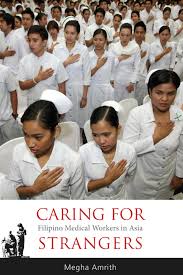In Caring for Strangers: Filipino Medical Workers in Asia, Megha Amrith examines the personal narratives, experiences and aspirations of Filipino medical workers who are living and working in Singapore as one of the many destinations that appear to offer a lucrative and stable career overseas. This ethnographic study offers a comprehensive insight into its participants’ lives, writes Michael Warren, and shows the multiple articulations and meanings of care as it crosses borders.
Caring for Strangers: Filipino Medical Workers in Asia. Megha Amrith. NIAS Press. 2017.
Find this book (affiliate link): ![]()
 Peering beneath the NHS bonnet, you will find that its fuel is significantly comprised of migrant medical workers. Around 134,000 NHS staff in England are non-UK nationals, making the UK one of the many jigsaw pieces of the globalised and interdependent healthcare sector, interlocking thanks to the glue of globetrotting workers and cross-border initiatives. The anthropological, migratory and health policy ramifications of globalised healthcare are at the forefront of Megha Amrith’s Caring for Strangers: Filipino Medical Workers in Asia. Amrith’s interest in this area stems from her expertise as an urban anthropologist of migration, currently working as a Research Fellow at the United Nations University Institute on Globalization, Culture and Mobility. Although Amrith’s book is an analysis of the lives of Filipino medical workers in Singapore, there are worldwide lessons for policymakers and readers with a healthcare interest.
Peering beneath the NHS bonnet, you will find that its fuel is significantly comprised of migrant medical workers. Around 134,000 NHS staff in England are non-UK nationals, making the UK one of the many jigsaw pieces of the globalised and interdependent healthcare sector, interlocking thanks to the glue of globetrotting workers and cross-border initiatives. The anthropological, migratory and health policy ramifications of globalised healthcare are at the forefront of Megha Amrith’s Caring for Strangers: Filipino Medical Workers in Asia. Amrith’s interest in this area stems from her expertise as an urban anthropologist of migration, currently working as a Research Fellow at the United Nations University Institute on Globalization, Culture and Mobility. Although Amrith’s book is an analysis of the lives of Filipino medical workers in Singapore, there are worldwide lessons for policymakers and readers with a healthcare interest.
In light of Brexit and the divisions between open and closed societies when it comes to migration, Amrith offers a timely three-dimensional perspective on migration. Amrith tackles the complex dynamics of care and migration to accurately show the many sides of care and dependency in migrant medical workers’ lives and those around them: ‘medical workers […] leave the Philippines to care (most often distantly) for their families, to care for themselves and their futures, while caring for strangers in Singapore’.
Working abroad is engrained in Filipino culture, with over 2 million working overseas. Working abroad enables Filipinos to strive for self-betterment and allows them to send remittances back to their families. Migration is not simply a single journey between ‘A’ and ‘B’, however: migrants frequently engage in ‘step migration’, working in different countries before reaching their final ideal destination. Singapore is often the first choice for Filipino medical workers en route to places such as Canada and the UK.
To migrate, a migrant must imagine a better place that they are travelling to. Imagination must be coupled with reality, though, and Amrith charts this through a ‘cartography of care’. This term encompasses the ‘imaginative maps of migrants’, the journeys they actually embark on and the many forms that care takes as they traverse the globe. Migrants build images of their next destination through films (such as Dubai (2005)), the promises of international recruiters, word of mouth, online communication with Filipinos abroad and social media.
Image Credit: Crop of ‘nurse’ by vallgall licensed under CC BY SA 2.0
Social media is particularly fascinating for the two-way street of enticement and display: the vivid online pictures of opulence and ‘making it’ can tempt migrants to come to a faraway nation, whilst posting the very same descriptions and images can serve to act as confirmation and evidence that this was the right choice for a migrant (one nurse in Saudi Arabia laid out her first salary in cash, posted as a photograph on Facebook). One explanation for this behaviour is that migrants who move abroad often never fully realise their ambitions; this can then cause a reversal of imagination where a migrant apparently longs for home but really this state of mind is a ‘temporary space for the denial of hardships of life overseas’.
One such hardship of overseas work is grappling with the misalignment of the skills learnt in the Philippines and those in migrants’ new destinations. Nurses are highly respected in the Philippines and view themselves as well-trained professionals, but many of Amrith’s interviewees were treated in the opposite manner in Singapore. One nurse bluntly described Singaporean patients’ expectations:’to them we are just maids, here to clean them, wipe their asses. They don’t respect us. We are professionals, we have degrees. The Singaporeans don’t even have degrees, only diplomas.’
Readers of Caring for Strangers can tangibly sense how much the little acknowledgement of medical expertise and the domestication of nursing create anxiety for Filipino medical workers. This is amplified by the interviewees’ own belief that if it was their family, they would be performing this bedside care, and their surprise that Singaporeans are relinquishing such a role to a stranger whose training is orientated to the medical side of care.
The two countries are therefore truly divergent in how care is perceived and even commodified, with a group of private hospital nurses noting to Amrith that whereas in the Philippines a nurse will be implored ‘please can you help me nurse, my mother is sick’, in Singapore it is a demand of ‘hey, we pay you for what?’ Singapore’s propensity for business-like care is typified when Amrith recounts a government hospital’s two-day orientation for new nurses and technicians to learn how to ‘put customers through “sunny-side up” service and CARE (Confidence, Attentiveness, Respect, Empathy)’. New recruits even practise their smiling skills and hone their eye contact: ‘look at the T zone, don’t glare into the eyes, have a gentle gaze, not hawking eyes’ (also helpful tips for a Londoner on a Monday morning tube journey).
It is to Amrith’s credit that she does not just offer analysis, but also briefly provides solutions to some of the friction between Singaporeans and Filipinos, such as the better use of urban space to enable people to ‘interact and care for each other in close proximity’. However, this could be fleshed out more. Perhaps, however, it is not the role of anthropologists to come up with solutions; rather, it is the duty of policy experts. Another, more familiar, criticism of the book is the lack of patient voices. Even though it is focused on elucidating the distinctions between different migrants’ lives and perspectives, a patient voice can act as an ‘other’ or counterweight for fuller understanding. This sometimes occurs in the book’s narration of tender moments of rapport between Filipinos and those they care for, such as a nurse-turned-phlebotomist who continued to visit her former patients even when her occupational responsibility ceased, comparing one Singaporean she visited to her mother.
Amrith competently builds an understanding with those she studies, vividly conveying the ‘sense of longing’ of many migrants rather than falling back on cold economic and rational explanations for migration. She diligently weaves a complete tapestry of Filipinos’ lives, tailoring her interviewing stance for each interviewee and paying attention to differences based on professional scope of practice, gender, religious background and other factors. This book is an important contribution to studies of migration from an anthropological perspective; readers who enjoyed this may also revel in the different historical approach utilised in Empire of Care: Nursing and Migration in Filipino American History. Amrith’s study is a thoughtful book that goes some way to understanding the motivations and manifestations of care, showing that its provision is not straightforward and can be articulated in different ways – as ‘an aspiration, a value, a practice and a form of labour’ – as it crosses different geographical and societal borders.
Note: This review gives the views of the author, and not the position of the LSE Review of Books blog, or of the London School of Economics. The LSE RB blog may receive a small commission if you choose to make a purchase through the above Amazon affiliate link. This is entirely independent of the coverage of the book on LSE Review of Books.








